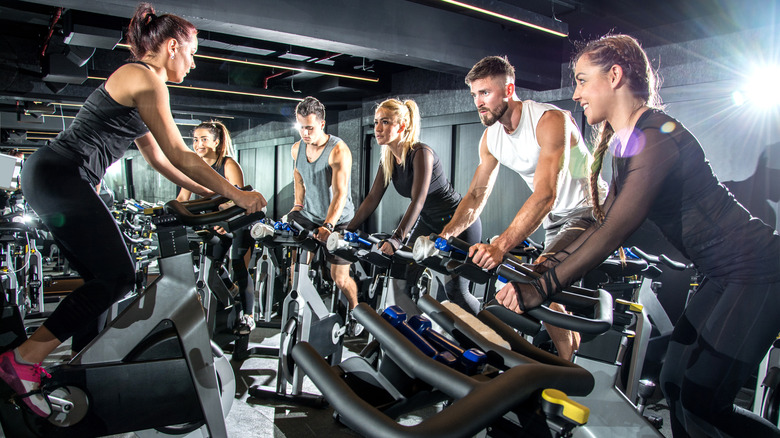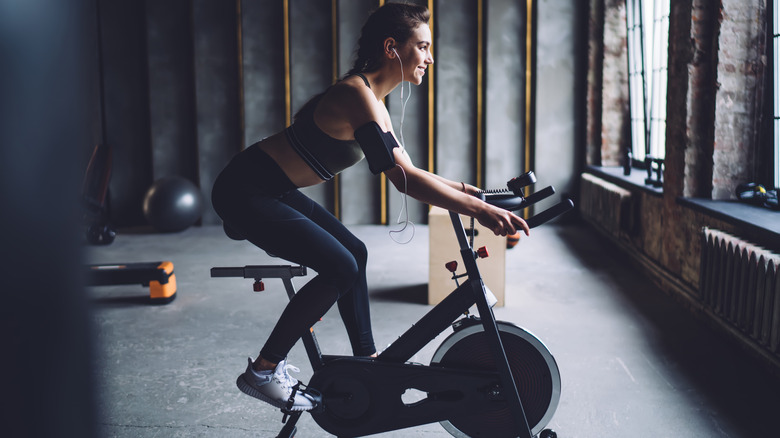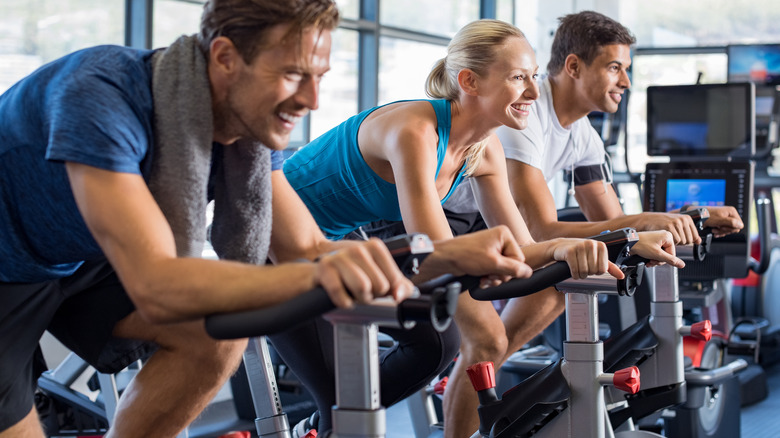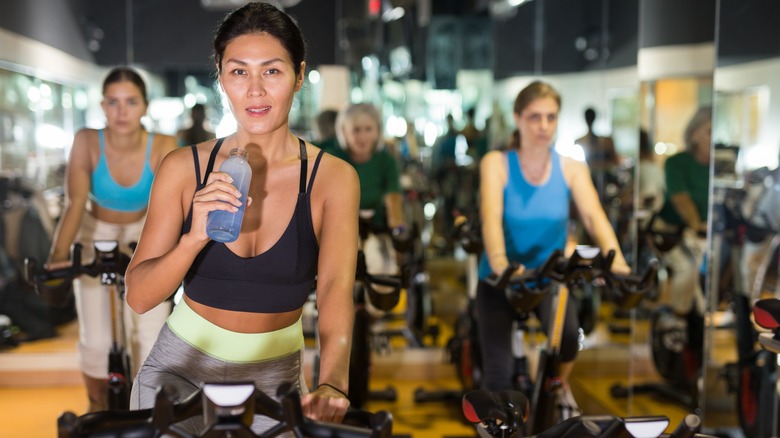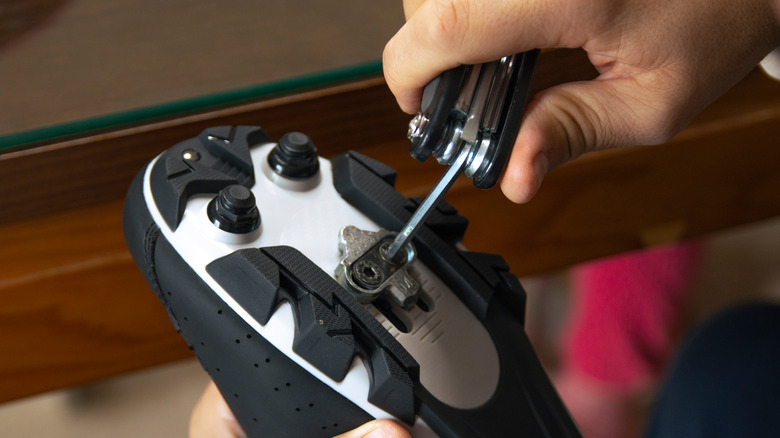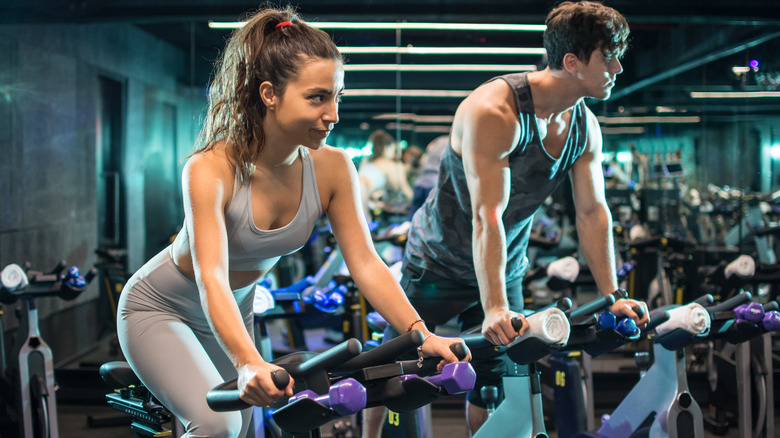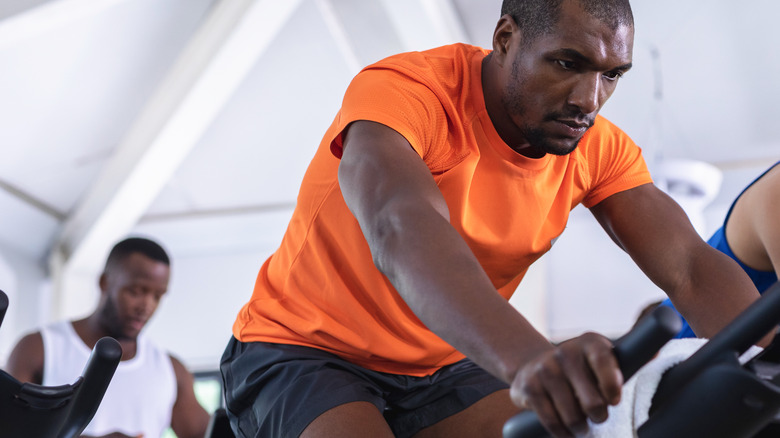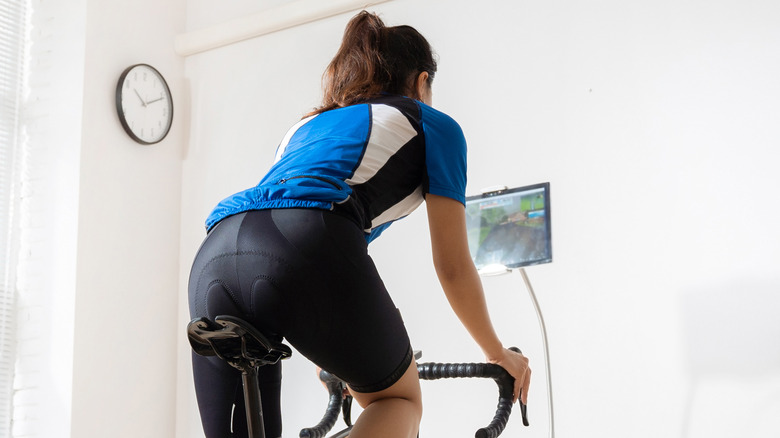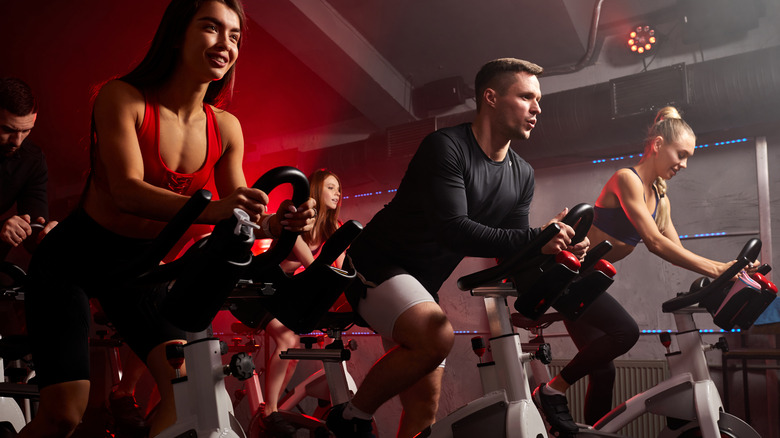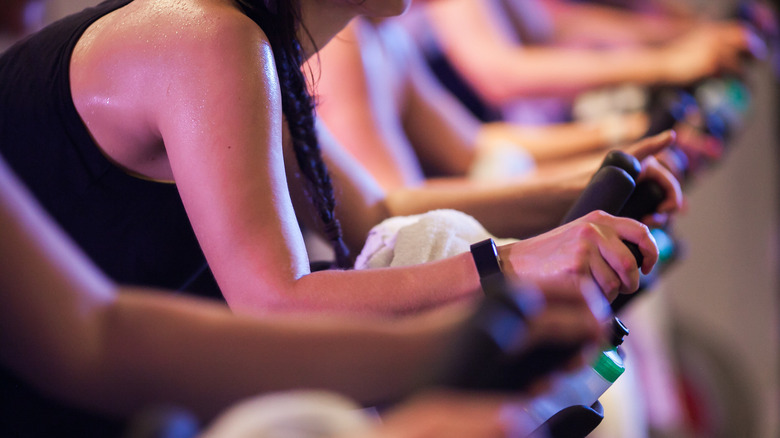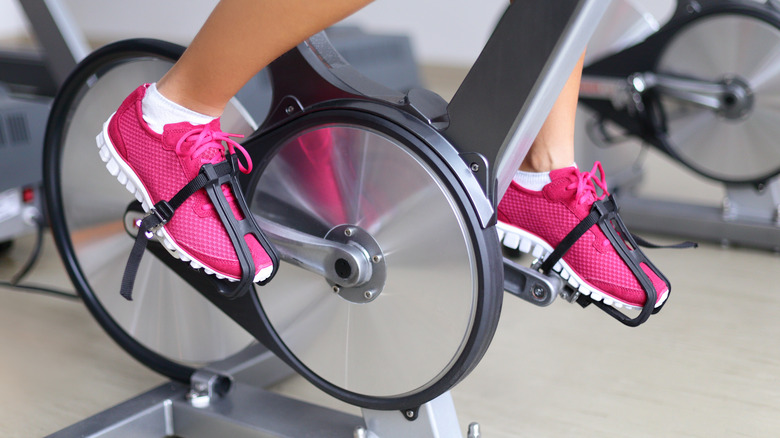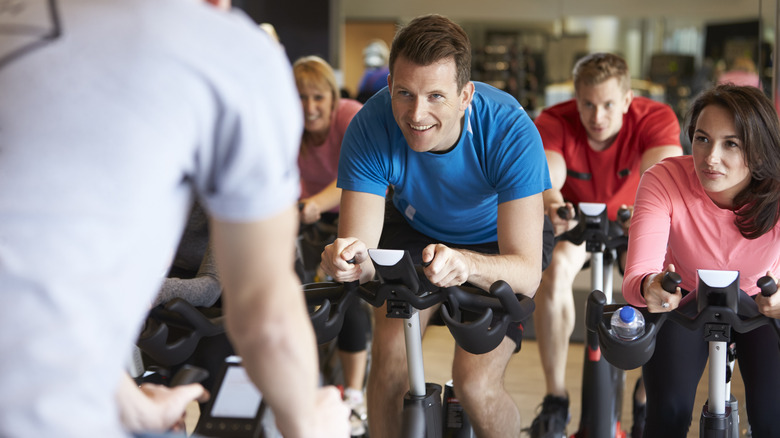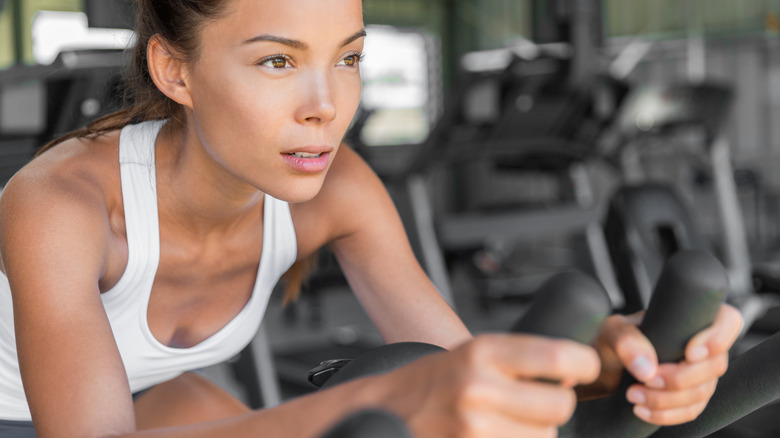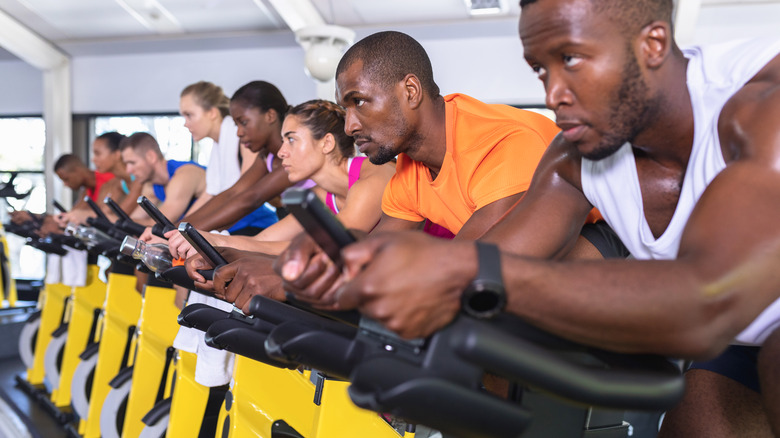14 Things You Should Know Before You Take Your First Spin Class
Whether it's the loud music, the darkness, or the sheer intensity in most spin rooms, something about spin class is inherently intimidating to beginners. For the uninitiated, spinning is a group fitness class that takes place on stationary bikes. These are not your standard gym stationary bikes though. Unlike the humble recumbent bike that lends itself well to a workout that includes reading your favorite novel, spin bikes require more focus to operate; they are not intended to provide a leisurely workout. This does not mean that spin isn't suitable for newbies (via TopFitness Magazine).
Spin bikes all have a front wheel that is connected to a flywheel, which moves when you pump the pedals (via Sports Rec). You can adjust the resistance you feel by turning the knob in the center of the bike. To increase resistance, you turn the knob clockwise; to decrease it, you turn it counterclockwise.
If you are feeling anxious about stepping into your first spin class, know this: everyone was new once and you'll likely be welcomed into the community-oriented class with open arms. Nevertheless, there are some things you should know before you get started.
Arrive early
Arriving at a group exercise class early might seem like a no-brainer or an impossibility, depending on the type of person you are. But for your first spin class, it is pretty important that you show up early. This will allow enough time for the instructor to help you set up your bike or it will allow enough time for you to fiddle around with your bike — though it is recommended that you utilize the expertise of the instructor.
Giving yourself enough time on the bike before you start pedaling will help ensure that you feel comfortable, get a good workout, and have fun throughout the class. Riding a spin bike can be a somewhat jarring experience — both on the body and the psyche — so it is imperative to find a comfortable and biomechanically sound position before class even begins (via Total Women's Cycling).
Arriving early will also give you some time to release the jitters you might be feeling. You'll be able to make sure your water bottle and towel are in the right position and maybe even engage in some friendly small talk with some of the other attendees.
It doesn't have to be an intimidating experience
Spin classes don't have to be completely intimidating. Sure, your first time doing anything can incite some nerves, but once you confront those nerves, you'll be pedaling away like Lance Armstrong. One of the elements that makes spin classes appear intimidating is the fact that all of the participants emerge from a dark room dripping sweat (via Self). If you're used to the light glisten you experience during yoga, this can be, well, a lot. However, spin classes are fully customizable.
If you are unnerved by the amount of effort spin veterans appear to exert, fear not. Since you are in control of the amount of tension on your bike, you get to choose how hard you push your body. Knowing that you are in charge of your efforts can help spin class feel less grizzly and more like a workout that is accessible to most bodies (via Well+Good).
Spin classes are suitable for beginners
Despite the intensity with which experienced spinners spin, spin classes are in indeed totally suitable for beginners. Even if you are brand new to working out in general, spin class is a great workout to add to your repertoire. You control the tension you inflict upon your bike and thus your legs so you get to dial in every part of the workout.
As opposed to a boot-camp style class where even some modifications can be dizzying if you're new to exercise, once you're set up on your spin bike, you have free rein. As you ride, the instructor will cue you to add tension, remove tension, stand or sit, increase your cadence, and more. Nevertheless, you should only do these things if you want to and if your body feels comfortable doing so. This is especially true for beginners.
"The most important thing to remember is [that] you control how hard the class really is," Sherica Holmon, a Flywheel instructor, told Well+Good. "When you need to catch a breath, slow it down and jump back in when you're ready. Just try your best and have fun." If a tough, standing climb on a spin bike makes you feel any type of discomfort, you can skip it. If pushing your pace makes you feel wobbly and out of control, skip it! No one is going to judge you. It can feel isolating and scary to cop to being a newbie, but your instructor will be happy to see you advance in whatever ways best serve your body and fitness goals (via Well+Good).
Bring water
We know, we know — you may be able to push through a Zumba or barre class without lugging around your heavy, reusable water bottle. But when it comes to spin class, it is even more important to bring your water bottle and keep a keen eye for hydration as you work out, especially if you're new.
According to Spinning, as much as 60 ounces of water can leak from your body in the form of sweat during an intensive, one-hour workout. Of course, this depends on your body mass, the humidity, and the environment in which you are working out. Spin classes tend to get steamy and humid, hence the concern with hydration before and after.
You don't want to overdo the liquids before, during, or after, but following general hydration guidelines can help ensure that you feel your best after your first spin class. In the hours leading up to your first spin class, Spinning recommends drinking 16 ounces of water. But pace yourself — it won't be quite as beneficial to chug it right before your workout and might lead to discomfort as you ride. Additionally, bring your water bottle and take in 16 to 24 ounces of water during your spin class and then replenish some of the liquid you lost in the form of sweat shortly thereafter. By finding the balance of hydrating before, during, and after, your body will be able to perform and recover better, which will help you enjoy spin class more overall.
Don't get hung up on clipping in
Perhaps one of the most intimidating things about being new to a spin class is the concept of "clipping in." And even if you are not intimidated by it, it can feel awkward unless you have a lot of experience. Some cycle studios provide spin shoes to rent, which can be a great way for you to try clipping in before you invest in your own pair.
To clip in, you'll align the cleat on the shoe with the slot on the pedal, which is far easier said than done. You'll push down through the ball of your foot until you hear a click and then you'll know you're locked and loaded. To remove your feet from the pedals, you'll kick your heels out away from the bike and the cleats on the shoes will be released (per RTE). "Being clipped in means you have a more efficient pedal stroke as you can pull up as well as push down," Dan Little, head of Digme, a spinning studio, told RTE. "Your hamstrings and glutes therefore, work harder than if you were cycling in trainers — trust me, this is a good thing!"
But if all of that information makes your head spin, you can stick with whatever run-of-the-mill exercise shoes you normally wear. Spin bike pedals often come equipped with baskets, or toe cages, with straps that can tighten around your shoe and hold your foot in place (via Spinning).
Yes, you'll need to configure your bike
The setup of your spin bike, especially for your first class, is incredibly important. Not only will the proper set up help you remain as comfortable as possible during your first ride, but a biomechanically correct bike configuration could help prevent overuse injuries. To prevent any complications, you should take the time to set your bike up properly before you spin.
Fitness First recommends beginning by standing next to your bike to adjust the saddle so it is even with your hip bone. You can adjust how close or far away the saddle is from the handlebars and you can also adjust the height of the handlebars — though this is likely something you'll need to do after taking a few pedal strokes with the saddle at the right height. Once the saddle height is adjusted, you'll hop on the bike to determine whether or not the seat is properly configured. You want to have a slight bend in the knee when your leg is fully extended and adjust so your knee is aligned over your foot as you pedal.
Super-spinners often drop their handlebars to mimic the positioning of competitive road bikers, but this is not necessary for rookies. You'll want to emphasize comfort and power when it comes to adjusting your handlebar position. If they are too low and you do not have the core strength to support this, you could end up with lower back issues as a result. You can start with your handlebars in a higher position and then gradually lower them as you get stronger and start to dial in the amount of power you can generate.
Adjust the resistance as needed
Part of what makes spin such an accessible workout for new exercisers is that, aside from the instructor shouting over the pounding bass and Eminem lyrics, it is pretty self-paced. Ensuring that you are comfortable adjusting and regulating your own gear and effort could make or break your first spin class. After all, if you leave in such a state that sitting down to go to the bathroom for the next few days is painful, you aren't super likely to return to class. If, however, you leave with just some heaviness in your legs, some sweat on your back, and a smile on your face, you'll be far more inclined to return.
Since spinning is a cardiovascular activity, it is important to self-pace so you don't run out of gas early on in the class. "Don't be tempted to go off like a rocket — you will probably regret it and it will make the experience a lot less enjoyable if you are hanging on for the last 20 minutes," Dan Little, head of the spinning studio Digme, told RTE.
If you're unable to keep up with the pace and intensity of the class, don't worry — everyone has to start somewhere! The instructor has to create a class for all levels and sometimes this can feel far too aggressive when you are new. Even if they are encouraging spinners to turn up the gear, keep or adjust your resistance based on what your body needs (via RTE).
Your clothing choices can make a difference
When getting prepped for your first spin class, it is important not to get too hung up on what kind of outfit you'll wear. After all, you are likely going to sweat through every inch of clothing, so there is no need to focus on any type of fashion moment. However, investing in a few key articles of clothing might make your spin career a bit more comfortable. Keep in mind that these clothing recommendations are to enhance comfort — they are not necessary to buy before your first class.
A pair of shorts with some light rear padding is a good garment to help ease some of the butt soreness that results from too much spinning (via RTE). For women, a strong and supportive sports bra can make a huge difference in the comfort of your ride as well, per Total Women's Cycling. The up and down motions on the spin bike definitely create a need for some security in that area, so you'll be way more likely to enjoy your spin class if you plan and dress accordingly.
Bring earplugs
Spin instructors use music (and volume) to create a whole vibe in a cycle studio. And it works — the thump-thumping has a distinct way of encouraging you to get the best workout possible (via Healthline).
In some cases though, this motivational music can go beyond what has been deemed safe by the National Institute for Occupational Safety and Health (via CDC). Continuously listening to music at 100 decibels or higher can lead to long-term hearing loss. Furthermore, listening to music at those volumes is only recommended for a maximum of 15 minutes per day.
However, Vox reported that "a single 45-minute indoor cycling class was nine times the recommended noise exposure for an eight-hour workday." While the noise-related health repercussions of spin classes have been pretty well documented, it doesn't seem like the noise level in a spin class is bound to change any time soon. To protect your hearing, grab a pair of earplugs before your first class. Also, know that the sound levels of spin classes are not all equally loud If one studio plays music that hurts your ears, you can likely find a class that suits your desires and needs better.
Expect to sweat
As you well know, sweat is a regular part of life and being human. Sweat is an even more normal part of participating in exercise — especially in spin classes. In fact, not sweating while you work out is more of a cause for concern than dripping a few droplets while you find the beat on your stationary bike. One of the main causes of not sweating is dehydration, which is why it is so important to follow hydration protocols before, during, and after an intense workout (via Healthline).
Sweating is your body's natural way of cooling itself down, so it makes sense that a steamy spin class is a great place to find yourself sweating up a storm. If you have concerns about your sweating, or lack thereof, chat with your doctor. But if excessive sweat is the main reason you are avoiding a spin class, bring a towel and embrace it. You can always toss a change of clothes into your gym bag. Do whatever you need to do to celebrate your naturally, spin-sweaty body!
Focus on taking full pedal strokes
Taking full pedal strokes as you ride is a great way to encourage balance and a consistent cadence as you work your way through your first spin class. While focusing on full, circular pedal strokes is easiest when you are riding clipped in, it is totally possible to execute this movement by just snuggling your traditional exercise shoes into the toe cages. Ensuring that your pedal strokes are as rotund as possible will help you engage the muscles in the legs more completely, according to Active.
In thinking about the pattern your foot traces as you pedal, it helps to think of a round clock face, advised Total Women's Cycling. From 12 to 5, you push down through the ball of your foot and your heel. From 5 to 7, you can point your toes slightly to engage your calves as you prepare for 7 to 9, which is the pre-upstroke. Lastly, from 9 back to 12, you engage in a full upstroke as you drive your knee up towards your wrist that is resting gently on your handlebar.
Your butt will probably hurt after your first class
You may walk away from your first spin class with some butt soreness. This is okay, totally normal, and frankly, to be expected. After all, cycling puts pressure in places that many of us are unaccustomed to having pressure. As you spin your way through your first class, most of your body weight will be resting on two of the itty-bitty bones in your pelvis. This is the culprit when it comes to soreness, SoulCycle instructor Maddy Ciccone told Refinery29.
While some amount of soreness can be expected, there are a few ways to lessen the effects. For one, make sure that your bike seat and handlebars are adjusted correctly to accommodate your body. You should make sure that you are utilizing the entire saddle, instead of perching on the narrow, front portion of the seat. Your spin instructor will likely have you standing up as you pedal, to decrease the amount of time bearing weight on your two small pelvic bones. Use these moments to give your butt a much-needed break. Engaging your core as you ride is another way to save your buns, and, of course, padded shorts can help (via Refinery29).
Relax your grip on the handlebars
Spinning is a cardiovascular activity that really emphasizes working the muscles in the lower body — so you can go ahead and release your death grip on the handlebars. Squeezing the s*** out of the handlebars won't help you generate more power, even though during a super tough interval, it may feel like it can. In fact, riding in this way can actually inhibit your body's ability to generate power and leave your wrists, neck, and lower back at a greater risk of injury (via Shape).
To begin, make sure that your bike is set up properly. We really cannot overemphasize how important this is to the comfort of your ride. Softly place your hands on the handlebars and draw your shoulder blades back and down. Then, draw your belly button up and in to engage your core and protect the integrity of the spine (via OpenFit). Focus on keeping weight off of the handlebars as you ride, even when you're standing, for the ultimate relaxed grip.
Don't forget to breathe
You have to breathe to get through a spin class! This is the most important — yet easiest to forget — element. Of course, your body is not just going to forget how to breathe and stop because of how overstimulating a spin class can be. But it can be hard to focus on your breath when the world around you is pulsing, people are yelling, and your leg muscles feel like they are on the verge of collapse.
Breathing properly is super important for getting through the workout, but also for your future fitness (via Spinning). Taking full steady breaths before you are totally gassed can help increase your fitness and cardiovascular work capacity over time. It can also help improve your circulation, the health of your heart, and lead to your muscles producing less carbon dioxide as you work out, according to Healthline.
If during your first spin class you start to feel like you need to dial it back, taking some time to focus on deep, even breaths can help get you back into enjoying the energetic moment.

